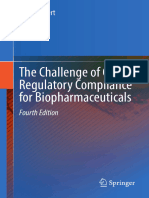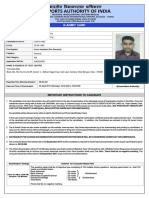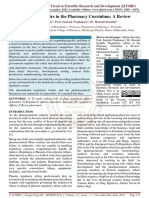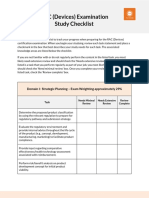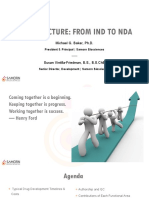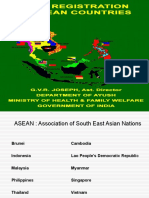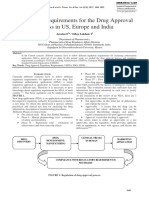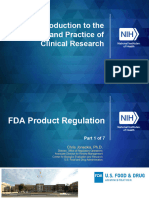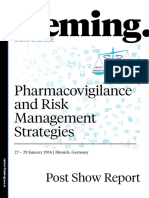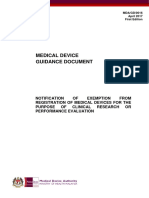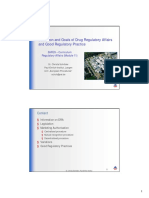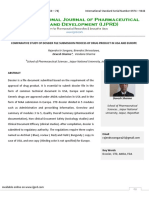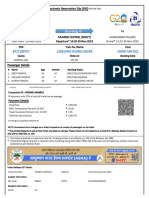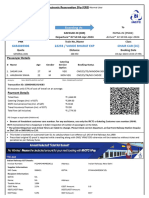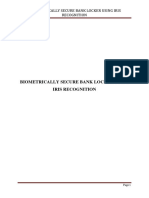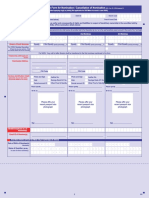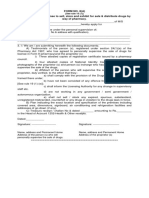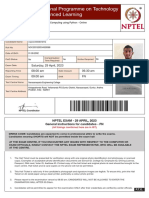Regulatory Affairs Certification (Drugs) : Candidate Guide
Uploaded by
AmarRegulatory Affairs Certification (Drugs) : Candidate Guide
Uploaded by
AmarRAPS.
org/RAC
Regulatory Affairs
Certification
(Drugs)
Candidate Guide
May 2020
Regulatory Affairs Certification (Drugs) Candidate Guide 1
RAPS.org/RAC
CONTENTS
Welcome................................................................................................3 On Examination Day....................................................................... 11
Introduction............................................................................................... 3 What to Bring to the Testing Center......................................... 11
Value of the RAC..................................................................................... 3 Items Prohibited at the Testing Center.................................... 11
About Certification................................................................................ 3 Other Considerations........................................................................ 12
Cancellation Due to Inclement Weather................................. 12
Examination Security and Confidentiality............................... 12
Preparing for the Exam.....................................................................4
Termination of Examination Administration/
RAC Examination Overview.............................................................. 4 Dismissal From the Testing Center............................................ 12
Preparing for the Examination......................................................... 4 Problems at the Testing Center.................................................... 12
Question Types........................................................................................ 4
Computer-Based Testing.................................................................... 5
Your Journey............................................................................................. 5 After the Examination.................................................................... 13
Examination Scoring........................................................................... 13
Notification of Examination Results........................................... 13
Applying for the Examination.........................................................6
RAC Recognition.................................................................................. 13
RAC Application Process.................................................................... 6 Use of the RAC Designation.......................................................... 13
Testing Windows and Application Deadlines........................... 6 Retaking the Examination................................................................ 13
Eligibility Requirements...................................................................... 6 Release of Information...................................................................... 13
General Application Instructions.................................................... 7
Submitting Payment.............................................................................. 7
Application Receipt Confirmation.................................................. 7 Recertify.............................................................................................. 14
Application Audit..................................................................................... 8 Maintaining Your RAC Credential.............................................. 14
Incomplete Applications...................................................................... 8
Application Rejection............................................................................ 8 Appendix A: RAC (Devices) Detailed Examination
Application Withdrawal/Cancellation and Refunds.............. 8 Content Outline................................................................................ 15
Transferring to Another Testing Cycle......................................... 8
Appeals Process....................................................................................... 8
Nondiscrimination Policy.................................................................... 8 Appendix B: Special Accommodations Request................... 18
Examination Scheduling...................................................................9 Appendix C: Documentation of Disability-Related Needs..... 19
Scheduling Your Examination........................................................... 9
Testing.......................................................................................................... 9 Appendix D: Code of Ethics.......................................................... 20
International Testing.......................................................................... 10
Changing Your Examination Appointment Addendum: Live Online Proctor Exams................................... 23
After it Has Been Scheduled.......................................................... 10
Emergency Situations........................................................................ 10
Failure to Schedule an Examination or Appear
for Your Examination Appointment............................................ 10
Special Accommodations for the Examination..................... 10
Regulatory Affairs Certification (Devices) Candidate Guide 2
RAPS.org/RAC
WELCOME
Introduction Value of the RAC
Congratulations on your decision to pursue Regulatory Affairs The RAC demonstrates to employers, clients and colleagues
Certification (RAC). We commend your commitment to your that a regulatory professional has the essential knowledge,
career and the regulatory profession. skills, critical thinking abilities and commitment to advancing
professional knowledge and abilities. As the demand for
This guide contains information about: competent regulatory professionals increases globally, RAC-
• RAC examination eligibility requirements credentialed professionals are well positioned to be effective
• Guidelines for submitting an examination application team members and contributors in every work setting.
• Preparing for the examination Recognition of the RAC continues to grow around the world
• How to schedule your examination and what to expect at and RAC-credentialed professionals earn higher salaries than
the testing center those who do not hold the credential.*
• What to expect after the examination In RAPS’ 2018 Scope of Practice & Compensation
Regulatory Affairs Certification (RAC), is the only post- survey for the Regulatory Profession, RAC
academic professional credential for regulatory professionals holders in North America reported earning an
in the healthcare product sector. It is intended for individuals average of 18% more than their counterparts
employed in regulatory agencies, industry, consultancies who do not hold the credential.*
and other settings involved with the regulation of healthcare
products. The RAC is a professional credential that denotes
commitment to excellence, pursuit of knowledge and career
About Certification
advancement. Success on the RAC examinations requires
knowledge of the appropriate regulations and the ability to The primary purpose of any professional certification
think critically about the regulatory issues and challenges that program is to provide an independent assessment of the
occur throughout the healthcare product lifecycle. knowledge, skills and/or competencies required for competent
performance of a professional role. This assessment is typically
accomplished by the successful completion of an examination.1
RAC-credentialed professionals
are among the current and
rising leaders in the regulatory
profession. To date, more than
8,500 individuals have earned
the RAC, some holding multiple
credentials.
*Based on data from the RAPS’ 2018 Scope of Practice & Compensation survey of the Regulatory Profession
1
Defining Features of Quality Certification and Assessment-Based Certificate Programs. (2010) The Institute for Credentialing Excellence.
Regulatory Affairs Certification (Drugs) Candidate Guide 3
RAPS.org/RAC
PREPARING FOR THE EXAM
RAC Examination Overview Preparing for the Examination
Each examination is based on a survey of the scope of The RAC examinations are challenging, so it is important to
practice and specific roles and responsibilities of regulatory develop a study plan to prepare for the examination. Your plan
professionals in the workplace with at least three years should be based on your knowledge, experience and preferred
of regulatory experience. Each examination is reviewed approach to learning. Here are some things to consider:
and revised annually and content is updated for the Spring
Review the examination content outline (see p. 15). The
exam cycle. Examination content for RAC exam is based on
examination content outline contains the content domains,
regulations and guidelines in effect on December 31 of the
competency statements and number of questions in each
year prior. So exams taken in 2019 will be based on regulations
___domain. Examination questions are based on guidelines and
‘on the books’ on December 31, 2018.
regulations effective 31 December of the prior year.
Knowledge Required and Regulatory Basis Assess the scope and depth of your knowledge and experience.
Use the test content outline as a checklist and evaluate your
• Knowledge of the full product development and areas of strength and weakness. This will help focus your study
lifecycle for pharmaceutical and medicinal and related on the areas you need most.
products, APIs, biologics and biotechnology products.
• Knowledge of US FDA requirements (30%); European Build and implement your plan. Allow sufficient time to build your
regulations and guidances from the European knowledge base in areas where you have limited experience and
Commission, EMA, and competent authorities (30%); to expand your knowledge in areas more familiar to you. Use
and globally applicable regulatory practices* (40%). reference materials to supplement your knowledge.
(*ICH, IGDRP (Generics) and WHO guidelines and
standards).Critical thinking and analytical skills. Question Types
• Critical thinking and analytical skills.
The examinations consist of 100 multiple-choice questions,
answered in a two-hour time limit. There are three question
formats which may be used in the RAC Exams.
Recall Recall questions ask for specific information,
typically about regulations and guidance
that are important aspects of the regulatory
process. These questions may relate to any
stage of product development and may relate
to regulations specific for product types.
Application Application questions require relating
specific knowledge to a situation that may
be encountered in the scope of practice of a
regulatory professional.
Analysis Analysis questions may be described as a
small case or example requiring the candidate
to read and assemble information in order to
identify and evaluate various solutions.
Regulatory Affairs Certification (Drugs) Candidate Guide 4
RAPS.org/RAC
Computer-Based Testing* Your Journey
The RAC examinations are computer-based and administered Check the RAPS website at https://www.raps.org/rac-
only at testing centers selected and confirmed by the testing credential/prepare/how-to-prepare-for-the-rac for additional
vendor. RAC examinations will not be stored or accessible resources that may be helpful to you. Some resources are free
through the internet and will not be offered at facilities that of charge and others are available for purchase. Resources are
are not pre-selected and qualified for security measures. not required to be RAPS produced.
* For candidates testing in the Summer 2020
RAC exam window only, a pilot scheme offering
PREPARE
Live Online Proctoring (LOP) is available. This
means candidates will have a choice whether
to test at home, or at a testing center. For
full details please see the addendum to the
APPLY
Candidate Guide.
SCHEDULE
TAKE EXAM
RECERTIFY
Regulatory Affairs Certification (Drugs) Candidate Guide 5
RAPS.org/RAC
APPLYING FOR THE EXAMINATION
RAC Application Process
You may apply for the RAC online or submit the printable
application form available on the RAC exam schedules
webpage.
Testing Windows and Application Deadlines
Application Deadline Testing Window
18 June 2020 13 July–21 August 2020
8 October 2020 2 November–11 December 2020
25 February 2021 22 March–30 April 2021
17 June 2021 12 July–20 August 2021
7 October 2021 1 November–10 December 2021
Applications and payment must be received by 11:59 pm (US
Eastern Time) on the application deadline dates listed above.
Applications received after the deadline will not be processed.
Examination Fees Eligibility Requirements
RAPS Member $485 (US) To be eligible for the RAC examination you need to meet one
2020 Prices of the following educational and professional experience
List $605 (US)
requirement combinations:
The RAPS member rate applies only if you are a member at • Baccalaureate or equivalent first university degree and
the time you submit your application. If you apply for RAPS a minimum of three years of regulatory or regulatory-
membership prior to submitting an RAC application, please related work experience*
be sure you receive confirmation of your RAPS membership • Master’s degree and a minimum of two years of
before you submit your RAC application. If you apply for RAPS regulatory or regulatory-related work experience*
membership after you submit an RAC application, RAPS will
• Doctorate degree and a minimum of one year of
not refund the difference.
regulatory or regulatory-related work experience*
Get information about RAPS membership online at https://
*Regulatory-related experience may include quality assurance,
www.raps.org/join-raps.
quality control, clinical research related to the approval of
health products or health product project management.
Regulatory Affairs Certification (Drugs) Candidate Guide 6
RAPS.org/RAC
General Application Instructions Submitting Payment
Include your name on the application as it appears on your The correct payment must accompany your application. You
government-issued photo identification (ID). If your name on may submit your application and payment in the following
your application does not match the government ID, you will ways:
not be allowed to sit for the exam at the testing venue.
Payment type Application submission method
Provide a valid e-mail address that will be maintained
Credit card Apply online, by fax or postal mail to:
throughout your RAC application period. If you choose to
Regulatory Affairs Professionals Society
provide a work e-mail address, please keep in mind that any
Attn: RAC Program Office
change in your employment during your application may mean
5635 Fishers Lane
you no longer have access to that e-mail account. email address.
Suite 550
All communications about your RAC examination, including
Rockville, MD 20852
information about scheduling your examination and examination
USA
results, are electronic. Please contact the RAC program office
at [email protected] if there is any change in your email Check or Postal mail only to:
address after you have submitted your application. money order Regulatory Affairs Professionals Society RAC
5635 Fishers Lane, Suite 400
Complete the RAC examination application fully. As part of the Rockville, MD 20852
application process, you must attest to the following: USA
• I have read, understood and agree to comply with all International Fax a completed application form and copy
policies outlined in the RAC Candidate Guide. wire transfer of bank wire confirmation to confirm your
• The information in my RAPS account is complete and application to:
accurate. RAPS Account
• I meet all eligibility requirements for the RAC exam, #1000043228997; ABA #061000104
and I authorize RAPS to make any inquiries deemed Swift Code SNTRUS3A; Suntrust Bank, 303
necessary to verify my credentials. I understand that false Peachtree St. NE, Atlanta, GA 30308.
information may be cause for denial of this application or
Must reference name of candidate. All
loss of the RAC credential.
bank charges are the responsibility of the
• I allow RAPS to use information from my application payer. For all wire payments: fax (+1 301
and from the examination for the purpose of aggregate 770 2924) or email ([email protected])
statistical analysis, provided that any personal a completed form and copy of bank wire
information or identifiers are removed. confirmation to confirm your registration.
• I understand and agree to the policies related to
withdrawing from the examination, presented in the
Candidate Guide.
Application Receipt Confirmation
• I acknowledge that I have read and understand the tenets You will receive an email notification thanking you for your
outlined in the RAPS Code of Ethics. order, which signifies that your application has been received.
If there are any questions about your application or your
Please see Appendix D (p. 20) for the Code of Ethics for application is selected for audit, you will be contacted by the
Regulatory Professionals. RAC program office.
Incomplete applications will delay processing and may cause
your application to be rejected if not completed by the
application deadline.
Regulatory Affairs Certification (Drugs) Candidate Guide 7
RAPS.org/RAC
Application Audit Transferring to Another Testing Cycle
RAPS may audit a percentage of applications for completeness A request to transfer to the next testing cycle may be made
and accuracy. If your application is selected for audit, you without charge before the application deadline. Requests to
will receive email notification of the audit, what types of transfer to the next testing cycle after the application deadline
documentation must be submitted and the deadline for but before the end of the testing window will incur a transfer
submission of requested documentation. If you do not comply fee of $250. Transfers will be allowed up to 10 days after
with the terms of the audit by the stated deadline, you will not the end of the testing window. After this period transfers
be allowed to take the test and your examination fee will be will not be allowed and applicants will be required to pay a
refunded minus a $100 processing fee. new application fee at full price. For individuals who require
a transfer due to an unavoidable emergency please see the
‘Emergency Situations’ section.
Incomplete Applications
If your application is incomplete, you will be notified by the Appeals Process
RAC program office, and the application deficiencies must
be corrected by the application deadline. Failure to submit Candidates have the right to appeal any adverse decision made
required information prior to the deadline will lead to rejection by the RAC program office. An appeal must be submitted in
of your application and you will be issued a refund of the writing not more than 30 days following the date of notification
examination fee, minus a $100 processing fee. of the adverse decision. Appeals should be sent to the RAC
program office at [email protected] or via US mail to RAPS
headquarters. All appeals will be addressed by the RACB.
Application Rejection
Decisions about appeals made by the RACB will be final.
Applications for RAC examinations will be rejected for failure
to meet eligibility requirements or falsification of application Nondiscrimination Policy
information. Rejected applicants will be refunded the
examination fee, minus a $100 processing fee. The RAC program does not discriminate among candidates on
the basis of age, gender, race, religion, national origin, disability,
sexual orientation or marital status.
Application Withdrawal/Cancellation
and Refunds
An application may only be withdrawn or cancelled before
the application deadline. Requests to withdraw or cancel
an application will not be accepted after this deadline. To
withdraw or cancel an RAC application, you must submit a
written request to the RAC program office at certification@
raps.org. There is a $100 processing fee for withdrawn or
cancelled applications.
Regulatory Affairs Certification (Drugs) Candidate Guide 8
RAPS.org/RAC
EXAMINATION SCHEDULING
Scheduling Your Examination Testing*
You will schedule your examination online directly with the To schedule your examination at a testing center, log into the
RAC program’s contracted testing vendor, Scantron. You Scantron scheduling site, you will be shown the available dates
will receive a “Notice to Schedule” email from Scantron and times at your selected testing center and you will select
approximately 10–14 days prior to the start of the testing your preferred testing date and time. Once you submit your
cycle with instructions about how to schedule your selection you will receive a confirmation e-mail.
examination. Please be sure that your email address can accept
emails from [email protected]. This email will contain a You should schedule your examination as soon as possible for
website link, unique login ID and password. You will use this the best chance of receiving your preferred testing date and
site to schedule a testing center ___location, test date and time.* ___location. You must submit your test scheduling request at least
four days prior to your preferred testing date. All examinations
must be scheduled four days prior to the close of the testing
* For candidates testing in the Summer 2020 cycle. Once you have scheduled your examination, you will
RAC exam window only, a pilot scheme offering receive a confirmation email from Scantron. You must bring a
Live Online Proctoring (LOP) is available. copy of the confirmation email with you to the testing center
Summer candidates will make their decision on test day.
whether to take LOP testing or to test at
Scantron reserves the right to cancel any testing site. In the
a testing center ___location at the time they event of a cancelled site, you will be notified by Scantron and
schedule their exam. For a full list of testing instructed about how to reschedule your testing ___location and
rules pertaining to LOP testing please see the appointment without additional fees.
addendum to this Candidate Guide.
Regulatory Affairs Certification (Drugs) Candidate Guide 9
RAPS.org/RAC
International Testing A personal medical emergency means that the candidate
has experienced a medical issue. Transfer requests are not
Applicants looking to schedule an examination outside of applicable for medical issues affecting family members. To
the US or Canada should follow the the instructions to apply for a transfer waiver the appropriate documentation
schedule through the Scantron scheduling site. However, must be submitted to the RAC program office no later than
should international sites/dates be unavailable at your 30 days of your scheduled examination date. Candidates will
preferred international ___location, you may click on the “More not be eligible for a refund following a transfer. Work-related
International Sites” button to see a full list of sites in our emergencies do not qualify for this exception.
network. Consider locations that you may be traveling to for
business or pleasure if you cannot find a ___location near your
home or office. You may then submit three (3) preferred Failure to Schedule an Examination or Appear
international site/date options. Scantron cannot guarantee for Your Examination Appointment**
availability of any international site/date during the designated
testing period. Within five (5) business days, Scantron will If you do not schedule an examination appointment or you fail
issue a confirmation notice for one of the preferred sites/ to appear for your scheduled examination appointment, you
dates. If none of the preferred site/dates are available, will be considered a ‘no-show’ and will forfeit all examination
Scantron will offer an alternate site/date for your approval. fees. The following are situations in which you will be
Upon approval, Scantron will issue a confirmation notice. considered a ‘no-show’:
• Failure to schedule an examination appointment during
Changing Your Examination Appointment the testing cycle
After it Has Been Scheduled • Failure to appear at your scheduled appointment
• Arriving at the testing site more than 15 minutes after
If you wish to change the date, time or ___location of an your scheduled appointment time
examination that has already been scheduled, and that you
• Failure to have appropriate photo identification at the
wish to take in the same examination window, you will need to
go to the link on your appointment confirmation email. If you examination appointment
have difficulty rescheduling online, you can contact Scantron If you fail to schedule or appear, you may reapply to take an
by telephone at +1 919 572 6880. A fee of $50 (US) for each
RAC examination in the future and will be required to pay full
change is required, payable to Scantron. Changes may not
application fees.
be made less than five business days before your scheduled
examination date. You may only reschedule to another date
within the current testing cycle. If you wish to reschedule to ** For candidates testing in the Summer 2020
another testing window, please see ‘Transferring to Another RAC exam window only, a pilot scheme offering
Testing Cycle.’ Live Online Proctoring (LOP) is available.
For a full list of testing rules pertaining to
Emergency Situations LOP testing please see the addendum to this
Under certain circumstances, as outlined below, the RAC Candidate Guide.
program may, at its discretion, transfer an applicant’s test to
the next testing window and waive the transfer fee. Special Accommodations for the Examination
If an applicant cannot take the RAC exam for one of the Candidates who require special accommodations under
following reasons: the Americans with Disabilities Act (ADA) and ADA
• A documented, personal medical emergency Amendments Act (ADAAA) should send the completed Special
• A death in your immediate family Accommodations Request Form with the Documentation
• Unexpected military deployment of Disability-Related Needs form (see Appendices B and C)
completed by a qualified professional, to the RAC program office
The applicant may request to transfer to the next testing cycle. at [email protected] or RAPS headquarters at the time of
In such circumstances the applicant must contact the RAC application. The request must indicate the nature of the disability
program office no more than five days after the scheduled and specific testing accommodations requested. Candidates will
examination date (if a date has already been scheduled be notified in writing if their request is approved.
through the testing vendor).
Regulatory Affairs Certification (Drugs) Candidate Guide 10
RAPS.org/RAC
ON EXAMINATION DAY
What to Bring to the Testing Center* Items Prohibited at the Testing Center
You should arrive at the testing center at least 15 minutes Candidates are expressly prohibited from bringing the
before your scheduled appointment for check in. You must following items to the test center:
bring a copy of the examination appointment confirmation • cameras, cell phones, optical readers or other electronic
email with you. devices that include the ability to photograph, photocopy
or otherwise copy test materials
To be admitted to the testing center you must bring current,
valid government-issued identification (ID). Your identification • notes, books, dictionaries or language dictionaries
must include your name (in English characters or translation to • book bags,luggage, purses or handbags
compare with your RAC application information), photograph • iPods, mp3 players, tablets, headphones or pagers
and signature. • calculators, computers, PDAs or other electronic devices
with one or more memories
You are required to present a valid, government-issued photo
• personal writing utensils (i.e., pencils, pens and
ID (e.g., driver’s license, passport, state-issued ID card) on
highlighters)
exam day; please ensure that your first and last name on the
valid, government-issued photo ID EXACTLY match your first • watches and other jewelry except wedding or
and last name as they appear on the scheduling screens. If engagement rings
your first and last names are incorrect, please contact RAPS • food and beverages
immediately at (301) 7702920, ext. 200. If you have more than • coats and jackets
one last name listed on your government-issued ID, the same • weapons
last names must be reflected on your confirmation email. If you
• Hats, hoods or other headwear are not permitted in the
do not provide appropriate and/or matching identification, you
examination room unless required for religious purposes.
will not be permitted to take the examination and will forfeit all
All items are subject to inspection by the proctor if
examination fees.
suspicious behavior is detected.
The following are acceptable forms of government-issued • Please note that sweaters and sweatshirts without
identification: pockets or hoods are permitted.
• driver’s license
• military ID
• passport
• national identification card
* For candidates testing in the Summer 2020
RAC exam window only, a pilot scheme offering
Live Online Proctoring (LOP) is available.
For a full list of testing rules pertaining to
LOP testing please see the addendum to this
Candidate Guide.
Regulatory Affairs Certification (Drugs) Candidate Guide 11
RAPS.org/RAC
You will be provided with: Termination of Examination Administration/
1. paper and pencil or erasable noteboards and markers at Dismissal From the Testing Center
the test center
You are expected to conduct yourself in a professional manner
2. have an abbreviations table
at all times at the testing center. The test center administrator
Please note that Scantron testing centers administer or proctor is authorized to dismiss you from an examination
examinations for multiple organizations. Individuals in the and/or request that a test score be cancelled if you engage in
testing room with you may be taking different examinations any of the following:
and have different rules for their examination including time • using or attempting to use someone else to take the
and what is allowed at their testing station. examination
• using notes or other study materials during the testing
Other Considerations process
• Smoking is prohibited. • creating a disturbance. Disruptive behavior in any form is
• You may not ask questions about examination content. not tolerated. The test administrator has sole discretion
to determine what constitutes disruptive behavior.
• All examinations are monitored and may be recorded in
both audio and video format. • communicating in any manner with anyone other than the
administrator or proctor during the testing process
• No breaks are scheduled during the examination. If you
need to leave the testing room to take a break, you will • leaving the testing room without permission
not be given extra time to finish the examination. You may • tampering with a computer
be required to present your ID when returning to the • removing or attempting to remove any material from the
testing room. testing room
• failing to follow any examination policies or requirement
Cancellation Due to Inclement Weather explained in this Candidate Guide
In the event of bad weather, a natural disaster or other
Problems at the Testing Center
emergency, Scantron will post the information on their
website. Candidates scheduled at a site operating on a delay The RAC program and Scantron take steps to assure
will receive an email from Scantron. Should the site be closed that the RAC examination process is effective. However,
entirely, Scantron will contact the candidates to reschedule. irregularities may sometimes occur. If you encounter technical
difficulties during the examination, please contact the proctor
Examination Security and Confidentiality immediately. If a delay exceeds 30 minutes, you may request to
reschedule your examination to another date if you are unable
The RAC examinations are the sole and exclusive property to wait any longer.
of the RAC program. These materials are confidential and
not available for review by any person or organization other
than the RACB and the examination committees. Copying,
publishing or disclosing examination content in any form is
considered a violation of the RAC Security and Confidentiality
policy and will be subjected to disciplinary action which may
include termination of a testing session, invalidation of test
results and/or revocation of an RAC credential.
Regulatory Affairs Certification (Drugs) Candidate Guide 12
RAPS.org/RAC
AFTER THE EXAMINATION
Notification of Examination Results
Examination results are typically available four to six weeks
after the close of the testing cycle. You will receive an email
notification with your results. Results are released only to
candidates. No results will be reported over the telephone or
by fax.
RAC Recognition
A list of all active RAC-credentialed professionals is available
online at RAPS.org/RAC. Newly credentialed professionals are
added after all candidates are notified of their status. If you do
not wish to be included in the online listing, please contact the
RAC program office.
Use of the RAC Designation
When you pass an RAC examination you may use the RAC
designation after your name as a professional credential.
You should list your RAC and specific RAC credentials
on your resume, curriculum vitae, employment or other
professional records. The RAC designation cannot be used by
individuals who fail to maintain the RAC credential by meeting
recertification requirements.
Examination Scoring Retaking the Examination
RAC examinations are scored by Scantron after the close Candidates who do not pass the RAC examination
of the testing cycle. Examinations are not scored at testing are eligible to retake the examination. To apply for re-
centers. A statistical report of scoring is reviewed by a examination, candidates must submit a new application.
statistician and the examination committee to assure ongoing There is no limit on the number of times a candidate can take
quality of the examinations. an examination. Candidates can retake the exam as soon as
the next testing window.
All scores are reported on a scale of 0 to 99 with 75 being
the passing score. The scaled score is neither the number of Release of Information
questions answered correctly nor the percent of questions
The RAC program maintains strict procedures for ensuring
answered incorrectly. You cannot look at the scaled score
the confidentiality of all candidate records. Information about
and determine the number of correctly answered questions
candidates is released only to the candidates themselves.
needed to pass the examination.
Scores are only released to the candidate and are not released
by telephone or fax even to the candidate.
Regulatory Affairs Certification (Drugs) Candidate Guide 13
RAPS.org/RAC
RECERTIFY
Maintaining Your RAC Credential Contact Information
Continual learning, knowledge enhancement and professional Regulatory Affairs Professionals Society
development are vital to regulatory professionals. Once Attention: RAC Program Office
certified, you maintain your RAC through continued learning 5635 Fishers Lane, Suite 400
and involvement in professional activities. You are required Rockville, MD 20852
to renew your RAC every three years by earning 36 RAC USA
recertification credits. Credits may be accumulated in many
ways, including participation in continuing education, public Tel: +1 301 770 2920, ext. 200
speaking on regulatory topics, professional writing and Fax: +1 301 770 2924
involvement with professional organizations. Email: [email protected]
Individuals who hold more than one RAC designation are only Scantron
required to submit a single recertification application with a 6001 Hospitality Court, #100
total of 36 credits. The recertification cycle is based on the Morrisville, NC 27560
initial RAC certification and the related recertification cycle. USA
You can find detailed information about maintaining and
renewing your RAC in the RAC Recertification Guide. Tel: +1 919 572 6880
Email: [email protected]
Regulatory Affairs Certification (Drugs) Candidate Guide 14
RAPS.org/RAC
Appendix A
RAC (Drugs) Detailed Examination Content Outline
Each examination is based on a survey of the scope of practice and Task 13: Develop strategies for regulatory authority interactions
specific roles and responsibilities of regulatory professionals in the (e.g., FDA/CA meetings, correspondence, documenting
workplace with at least three years of regulatory experience. Each verbal communication or commitments) to guide product
examination is reviewed and revised annually and content is updated development life cycle management.
for the October/November exam cycle. Examination content for the Task 14: Ensure regulatory compliance of company standard
RAC (Drugs) exam is based on regulations and guidelines in: operating procedures impacting internal stakeholders.
Domain I: Strategic Planning—Exam Weighting approximately 24% Task 15: Provide internal trainers with information on regulatory
requirements to incorporate in ongoing training programs.
Task 1: Evaluate the regulatory environment and provide internal
advice throughout the life cycle of the product (e.g., concept, Domain II: Pre-marketing—Exam Weighting approximately 37%
development, manufacturing, marketing) to ensure compliance.
Manufacturing Section
Task 2: Perform risk/benefit analysis on product development
concept for initial product viability. Task 1: Determine applicable regulatory requirements for
Task 3: Determine endpoints for safety and efficacy testing at the manufacturing and/or development of drug products.
feasibility phase to determine the ability to comply with
Task 2: Review documentation of raw materials to ensure
regulatory standards.
compliance with regulatory requirements (e.g., API/drug
Task 4: Advise research and development programs to ensure substance, novel excipients, animal-derived materials).
regulatory compliance.
Task 3: Review documentation (e.g., stability data, specifications,
Task 5: Provide regulatory intelligence to develop local, regional,
and global regulatory strategies that include determination investigational labeling) for adequacy to support IND/CTA
of regulatory classification, submission type (e.g., eCTD, submission.
electronic, paper) for regulatory applications, due diligence, Task 4: Ensure regulatory compliance of manufacturing and release
and internal/external license opportunities.
of investigational products for clinical use.
Task 6: Evaluate the regulatory outcomes of initial product
concepts and make recommendations for future actions. Nonclinical Section
Task 7: Evaluate and interpret regulatory decisions in a similar product Task 5: Determine nonclinical test requirements (e.g., GLP, toxicology
category to assess regulatory implications for approval. studies) and ensure compliance with applicable guidance,
Task 8: Identify and engage appropriate regulatory authorities for standards, and regulations for product-specific requirements.
submission of data concerning the product being developed. Task 6: Evaluate adequacy of nonclinical data and risk management
Task 9: Assess impact of local, regional, and global requirements activities to support initiation of clinical trials.
and considerations on the regulatory dossiers.
Clinical Section
Task 10: Consult with multidisciplinary teams to develop indications
for use, intended use, and product claims (e.g., target Task 7: Determine requirements for clinical development and
product profile, product requirements). ensure compliance with applicable guidance, standards,
Task 11: Evaluate the regulatory merits of domestic versus regional and regulations for product-specific requirements (e.g.,
or global submission strategies (e.g., simultaneous filings, ICH, GCPs, monitoring, auditing, ethics committee, safety
joint reviews, mutual recognition agreements, assessment reporting, informed consent, financial disclosure).
of similarity or dissimilarity of requirements) to define
market feasibility. Task 8: Ensure that reporting procedures are in place to
report adverse events that occur during clinical trials/
Task 12: Anticipate regulatory issues arising from trade-related
investigations to appropriate regulatory bodies.
matters (e.g., applicable treaty law, international
conventions, “for export only” status). Task 9: Generate and ensure regulatory compliance of product labeling.
Regulatory Affairs Certification (Drugs) Candidate Guide 15
RAPS.org/RAC
Task 10: Inform stakeholders of regulatory implications regarding Task 3: Submit notifiable changes and supplemental dossiers and
ongoing clinical trials/ investigations (e.g., protocol follow up with the appropriate regulatory authorities to
amendments, ICF amendments). achieve compliance.
Task 4: Ensure that appropriate standard operating procedures are
General Section
in place to manage product-associated events, complaints,
Task 11: Advise stakeholders of regulatory requirements for quality, adverse drug reports, recalls, market withdrawals, and
nonclinical, and clinical data to meet applicable regulations. vigilance reports in accordance with regulatory requirements.
Task 12: Assess the acceptability and completeness of quality, Task 5: Provide regulatory input for risk management strategy to
be presented to stakeholders and implement appropriate
nonclinical, and clinical documentation for submission filing
regulatory steps for selected options (e.g., consumer
to comply with applicable regulations (e.g., IND/CTA, NDA/ information, advertising, or labeling changes, warnings or
BLA/MAA submission, manufacturing transfer). alerts, product changes, recalls, withdrawals).
Task 13: Initiate and monitor the process to obtain nonproprietary Task 6: Implement regulatory strategy for handling communication
(e.g., USAN, INN) and proprietary names. to stakeholders for notifiable product-associated events,
complaints, adverse drug reports, and recalls (e.g., dear
Task 14: Manage outsourcing strategy (e.g., contract research healthcare provider letters, patient letters, distributor
organizations, subcontractors, test facilities, consultants) letters, health authorities).
using appropriate communication tools throughout the Task 7: Report notifiable manufacturing product-associated events
product development life cycle. (e.g., failures, recalls, corrective actions resulting from
Task 15: Compile and review regulatory submission packages in inspections) to regulatory authorities to maintain compliance.
accordance with applicable regulations. Task 8: Report product safety issues/failures to regulatory authorities
to comply with local, regional, and global regulations.
Task 16: Prepare or review study data and manufacturing
Task 9: Engage regulatory authorities and comply with product
information to ensure compliance with local, regional,
post-marketing commitments and requirements to meet
national, and international regulatory requirements. conditions of approval.
Task 17: Maintain authorization for ongoing clinical trials/investigations Task 10: Participate in crisis/issue management team (e.g., product
(e.g., amendments, annual reports, updates) and monitor the recall, counterfeiting) and assess the regulatory impact and
progress of the regulatory authority review process. resolution of product-related events.
Task 18: Evaluate proposed manufacturing changes on nonclinical and Task 11: Review regulatory aspects (e.g., quality, product complaints,
clinical development and regulatory submission strategies. recalls, vigilance) of contracts for product manufacturing
and distribution to ensure compliance.
Task 19: Facilitate the development of appropriate and timely
Task 12: Control access to regulatory documentation to ensure
responses to regulatory authority queries and actions to confidentiality and protection of proprietary information.
ensure compliance with company procedures.
Task 13: Maintain licenses (e.g., registration and listings, narcotics,
Task 20: Participate in developing a risk management system controlled substances) and submit renewals as required.
(e.g., vigilance) to ensure that local, regional, and global Task 14: File new and amended patent/trademark forms to update
regulatory requirements as applicable are met for the information with applicable regulatory authorities to meet
development program. regulations.
Task 21: Identify, monitor, and submit applicable reports (e.g., serious Task 15: Provide required information (e.g., clinical data) in support
of product reimbursement requests.
adverse events) or notifications (e.g., changes in manufacturing)
to regulatory authorities to comply with regulations. Task 16: Ensure compliance with regulatory requirements for lot
distribution and release.
Task 22: Participate in audits/inspections by regulatory authorities
Task 17: Provide regulatory oversight of quality system compliance
and contribute to responses to audit findings as required.
(e.g., ISO, GXPs, SOPs).
Domain III: Post-marketing—Exam Weighting approximately 28%
Task 18: Comply with import and export requirements.
Task 1: Evaluate advertising and promotional materials for
Task 19: Ensure compliance with applicable market controls and
adherence to regulations, guidelines, and standard
requirements (e.g., controlled substances, veterinary use only).
operating procedures to ensure compliance.
Task 20: Ensure adequacy of product traceability systems.
Task 2: Generate and evaluate product labeling (e.g., package insert,
instructions for use) for adherence to regulations, guidelines,
and standard operating procedures to ensure compliance.
Regulatory Affairs Certification (Drugs) Candidate Guide 16
RAPS.org/RAC
Domain IV: Interfacing—Exam Weighting approximately 11% Task 6: Advise stakeholders on the impact of current and proposed
legislation, regulations, guidelines, and standards and
Task 1: Advise on regulatory strategy for risk management process provide training when necessary to facilitate regulatory
to mitigate impact to company. compliance.
Task 2: Coordinate company presentations and development of Task 7: Communicate with legal counsel and company officials
briefing documentation for regulatory advisory committee, when appropriate to minimize exposure to legal liability.
agency representatives, and other government agencies to
facilitate regulatory compliance. Task 8: Participate on cross-functional product development teams
(e.g., individuals from CMC, quality, labeling, research
Task 3: Provide input on proposed legislation, regulations, and development, clinical, nonclinical, marketing, legal) to
guidelines, and/or standards to be followed by industry provide regulatory affairs expertise.
and regulatory authorities to ensure consistent and clear
application of requirements.
Task 4: Manage regulatory authority inspections to ensure All Tasks may be examined under the following knowledge or skill areas:
company personnel are well-prepared and understand a. Regulatory intelligence
inspection processes. b. Product development
Task 5: Evaluate legislation, regulations, guidelines, standards, and c. Risk management
related issues to facilitate compliance on regulated products d. Licensing, registration, and maintenance
and to support strategic planning. e. Post-market activities
Regulatory Affairs Certification (Drugs) Candidate Guide 17
RAPS.org/RAC
Appendix B
Special Accommodations Request
The Regulatory Affairs Certification Board (RACB) may provide accommodations to candidates with a disability as defined by the
Americans with Disabilities Act (ADA). Please review the RAC Candidate Guide before submitting this form to be sure you quality
for special accommodations.
Please Type or Print
First Last MI
Name
Street Mail Stop/Suite/Apt
Address
City State/Province Zip/Postal Code Country
Country & Area Code
Phone Email
For which of the following examinations are you requesting accommodations?
RAC (US) RAC (EU) RAC (CAN) RAC (Global) RAC (Devices) RAC (Drugs)
Type of accommodation you are requesting
Have you previously received accommodations in any educational or testing situation? Yes No
If yes, please describe the accommodations received
Signature Date
I certify that the above information is true and accurate.
Regulatory Affairs Certification (Drugs) Candidate Guide 18
RAPS.org/RAC
Appendix C
Documentation of Disability-Related Needs
To the Professional: The individual identified below is requesting accommodations for the Regulatory Affairs Certification (RAC)
examination. The Regulatory Affairs Professionals Society requires that candidates requesting testing accommodations provide
documentation of the disability from a person qualified to assess the disability.
By completing and signing this form, you are verifying that the individual named below has been diagnosed with the stated
disability and the recommended accommodation is required to fairly demonstrate the candidate’s ability on the examination.
Candidate First Last MI
Name
Country & Area Code
Phone Email
Please include the following:
1. Diagnosis (note: mental and emotional disabilities must include a diagnosis from the DSM-IV)
2. Description of the candidate’s disability and how the disability affects the candidate’s major life activities (e.g., hearing,
seeing, walking, talking, performing manual tasks)
3. Recommended Accommodations:
Signature Date
Regulatory Affairs Certification (Drugs) Candidate Guide 19
RAPS.org/RAC
Appendix D
Code of Ethics
As the international leader for the healthcare regulatory profession, Fundamental Principles
RAPS has initiated and supported the development of this code of As a regulatory professional I aspire to:
ethics for the profession. Following a series of surveys and focus
• To ensure my employer’s activities are conducted in compliance
groups held over two years, a task force of volunteers was convened
with the laws and regulations of the authorities under which we
in February 2003. Their work, reviewed and shaped by many
operate, consistent with advancing, preserving and protecting
regulatory professionals, forms this code.
public health.
The task force identified eight core values that regulatory • Be competent to perform the services I have been hired or
professionals embrace. The principles embodied by these core values retained to perform. As a regulatory professional, I hereby
are outlined in the section (below) entitled “Fundamental Principles.” commit myself to continual learning while being able to
Following that, each core value is presented with suggested behaviors acknowledge areas outside my expertise.
that should be encouraged or discouraged. • Act in an objective manner. As a regulatory professional, I
RAPS believes that this is a living document and encourages your will base decisions on factual information. I will not be unduly
feedback. Use this code of conduct in your work and share it with influenced by competing or conflicting interests and I will
your colleagues and employer. clearly communicate competing or conflicting interests when
appropriate.
Statement of Personal Responsibility • Have integrity. As a regulatory professional, I must be principled
Regulatory professionals have the professional and ethical responsibility and consistent in applying my views. I must live up to my
to maintain the highest standards of professional conduct as they commitments, and be trustworthy and scrupulous at all times.
exercise their professional duties of upholding and clarifying the laws • Be honest in all dealings with my employers and others with
and regulations of the authorities under which we operate. whom I interact. As a regulatory professional, I must ensure all
As individual regulatory professionals, we are making a positive information and communications, whether oral or written, are
contribution to public health and we aspire to embody this code of accurate and complete. I acknowledge and affirm personal and
ethics in our words, actions and deeds. institutional credibility is crucial to my success.
• Have the courage to make difficult decisions. As a regulatory
As regulatory professionals, we play a pivotal role in ensuring professional, I will present all relevant information to my
compliance with applicable laws and regulations in the development organization to promote wise decisions. I must be able to
and commercialization of healthcare products. We are a diverse withstand challenges to my views, while at the same time being
profession: we work in healthcare companies, for government accountable for my mistakes.
regulatory agencies, for contract research organizations and as
• Be fair in my dealings with all parties. As a regulatory
independent consultants around the world. Our profession includes
professional, I must apply legal and regulatory standards
attorneys, engineers, managers, nurses, pharmacists, physicians and
equitably. I must be just in considering the interests of all parties
scientists, among others. We are a growing profession and we are
in decision processes.
developing and continually exploring our core values in an increasing
complex global regulatory environment. We do this in the hope that • Be respectful of others. I must treat all individuals with dignity
everyone who practices in this field will aspire to these principles. and courtesy.
We do this also in the hope that those whom we serve will hold these
Duty
principles as inviolable.
Our role as regulatory professionals is defined by our duty to advise
The following eight core values defined below are maintained from
individuals and organizations regarding the appropriate regulatory
the original code:
context for actions they may want to take.
• Regulatory Compliance
Our role is further defined by our obligations as employees of
• Competency
companies making important medical products for patients, as
• Objectivity members of teams conducting nonclinical and clinical studies, as
• Integrity regulators and as members of our profession.
• Honesty/Credibility
Regulatory professionals have a duty to:
• Accountability
• Disseminate and interpret relevant governmental regulations,
• Equitability industry standards and good practice guidelines without bias.
• Dignity and Respect
Regulatory Affairs Certification (Drugs) Candidate Guide 20
RAPS.org/RAC
• Ensure products are safe and beneficial to patients, while Integrity
maintaining the long-term interests of our employers.
Regulatory professionals with integrity will not compromise
• Ensure, to the extent possible, the benefits justify the risks for their values or trustworthiness for personal gain or professional
those who participate in clinical studies and who use regulated enhancement. Individuals with integrity are principled, scrupulous
products. and trustworthy. Having integrity suggests that one is “whole,” and
• Provide physicians and other healthcare professionals with one’s beliefs, words and actions are congruent and consistent.
accurate and complete information about the safety and
Regulatory professionals develop and maintain integrity by:
effectiveness of products.
• Maintain the long-term integrity of our profession and strive to
• Keeping commitments.
deserve the public’s confidence and respect. • Giving credit for the work of others.
• Maintaining confidentiality of information and never disclosing
Competence information concerning the business or technical affairs of
Competence means a regulatory professional has the knowledge, others without their consent.
experience, ability and skill necessary to effectively identify, analyze • Seeking advice from others when uncertain.
and solve or recommend solutions to regulatory challenges. • Considering their obligations and the long-term consequences
Regulatory professionals must be dedicated and flexible enough to of their actions when asked to compromise integrity for the sake
adapt to the everchanging realm of the regulatory profession. of one party over another.
The diversity of individuals and organizational contexts within the
• Avoiding situations that put their integrity at risk.
regulatory profession necessitates commitment to continually • Recognizing the best course of action may not be in the short-
develop competence by a variety of means: seeking continuing term interest of their employer.
education, work experience, professional training and certification. • Accepting compensation only when earned.
Just as the regulatory profession continues to evolve, maintaining
• Avoiding conflicts of interest or making conflicts known when
they are unavoidable.
competence within the field is a continual learning process.
Regulatory professionals develop competence by: Honesty
• Being informed and knowledgeable about cur-rent and future Regulatory professionals must exhibit honesty in all of their activities.
trends. Honesty is truthfulness, candor and sincerity. Honesty requires a
• Claiming competence only in areas where they have a thorough regulatory professional to act in ways free from deceit or deception,
understanding. including dishonesty by omission or failing to say something when
• Encouraging and supporting professional growth and comment is ethically required. Honesty requires candid and
development among peers and subordinates so all who work in forthcoming actions, not simply refraining from false statements.
the field can gain and demonstrate competence in the profession. Regulatory professionals build honesty and trust, which is absolutely
essential to fostering effective working relationships, by:
Objectivity
• Ensuring information is accurate and complete.
Regulatory professionals must be objective and must display their
• Protecting against the omission of information or the creation
objectivity by representing facts without distortion by personal
of false impressions.
feelings or biases. The regulatory professional must understand the
facts and must evaluate information from several points of view.
• Resisting pressures to relax standards of honesty, for example,
to achieve expediency.
Regulatory professionals must understand their decisions may • Representing a complete profile of the product under review in
affect the interests of many parties including companies, regulators, all regulatory submissions.
healthcare professionals, patients and shareholders. Regulatory
professionals must be aware of these differing interests without Courage
letting them influence their final regulatory interpretations and
Regulatory professionals demonstrate courage by choosing the right
actions.
thing even when doing so is difficult. Regulatory professionals must
Regulatory professionals develop objectivity by: have the courage to evaluate, conclude and provide consistent and
• Responding carefully to opinions and issues and recognizing a accurate regulatory advice while accepting the consequences of their
single right or wrong answer is rare. Opinions can often take actions. They must gain access to information required to do their
on a partisan perspective. The regulatory professional should jobs as completely as possible.
always strive to offer an unbiased expression of facts. Regulatory professionals develop courage by:
• Presenting reasonable regulatory opinions, options and • Reviewing and reiterating their advice and strategy when
associated risks when developing regulatory strategies. necessary or when challenged and changing their advice when
• Clearly differentiating among regulatory requirements, internal appropriate.
requirements and personal preferences. • Asking for help when needed.
• Disclosing new information appropriately within the proper • Encouraging an open exchange of views even if those views
context. challenge their regulatory advice.
Regulatory Affairs Certification (Drugs) Candidate Guide 21
RAPS.org/RAC
• Admitting mistakes, accepting accountability and taking Respect
appropriate measures to promptly correct any errors,
Regulatory professionals demonstrate respect by appreciating
miscommunications or misperceptions.
the worth or value of people and things. Regulatory professionals
• Delivering bad news quickly to management when necessary. must respect the roles of their colleagues and should recognize and
• Providing information to stakeholders about regulatory risks acknowledge the worth of all parties.
and describing consequences if regulatory advice is overruled
Regulatory professionals develop respect by:
or ignored.
• Listening to what others have to say.
Fairness • Treating all parties, regardless of level or position, with dignity,
Regulatory professionals strive to treat all persons fairly, equitably civility and courtesy.
and equally in accordance with the law by holding all those with • Accepting personal differences but working diligently toward
common responsibilities to a common standard. Regulatory accommodating those differences where ever possible.
professionals should consider the rights and needs of all parties • Creating a positive environment encouraging participation of
in the context of all applicable laws, regulations and scientific and all parties without embarrassment, ridicule or hurtful actions or
societal norms. inactions.
Regulatory professionals demonstrate fairness by:
• Sharing what they know in a nonintimidating way.
• Respecting the letter and spirit of laws and regulations. • Tolerating and encouraging those who do not initially
understand.
• Applying the appropriate legal and regulatory standards to all
cases.
• Avoiding conflict where possible and finding creative ways to
resolve conflict quickly.
• Taking into account cultural and regional differences and local
requirements.
• Being patient and forgiving when others make mistakes and
working to prevent mistakes from recurring rather than
• Presenting the facts and objective analysis of scientific assigning blame
information using sound statistical interpretation to minimize
bias while clarifying uncertainty.
• Ensuring all interests, public and private, are appropriately
considered in the regulatory decision processes.
Regulatory Affairs Certification (Drugs) Candidate Guide 22
RAPS.org/RAC
Addendum
Live Online Proctor Exams
To increase flexibility and exam availability for candidates taking the º Your desk must be clear except for two pieces of scratch
RAC during the summer 2020 exam window, the RAC program is paper and a writing implement. You may be asked to show the
pleased to offer Live Online Proctoring (LOP) as an additional method paper to the proctor and the scratch paper will be destroyed
of testing. This will allow candidates the possibility of taking the RAC after the exam is completed.
exam from their home or office and is in addition to regularly available º There are no breaks during the exam and you are not
testing that takes place at our testing centers across the globe. permitted to leave your seat
LOP is offered during the summer 2020 exam window as a pilot º No talking is permitted except to the proctor.
scheme. At this stage, no determination has been made whether LOP º No food or drink
will be offered in future exam windows. º No hats, hoods, or other headgear, other than for religious use
Live online-proctored (LOP) test administration allows candidates º No coats or jackets
to complete their examinations from their own computers via an
• Authentication:
internet connection at a time and place of their choosing (during the
exam window). Testing sessions are available 24/7/365, based on º You will need a government-issued photo ID with signature
that matches your name as registered.
seating availability. The RAC program’s testing vendor, Scantron, uses
its proprietary software, Scantron PASS™, to deliver examinations º Username, password, and exam password from your
to candidates. Scantron partners with Examity for online, real-time scheduling confirmation email to start the exam.
monitoring of testing candidates. The candidate’s computer must What Candidates Will Need to Take an LOP Test
have webcam capability as well as a microphone and speakers, and the
environment should be quiet to avoid distractions and to ensure that The candidate’s computer must have webcam capability as well as
the online proctor can hear everything at the candidate’s ___location. a microphone and speakers, and the environment should be quiet
There are technical requirements, such as an adequate internet to avoid distractions and to ensure that the online proctor can hear
connection, to ensure that the proctor can access the candidate’s everything at the candidate’s ___location.
computer and that the session can proceed without internet You can run a basic test on your system at https://prod.examity.com/
disruption. Candidates are informed of the computer specifications in systemcheck/check.aspx
advance of the testing session.
Full Specifications
Basic List of Candidate Rules and Requirements
System requirements to run Scantron PASS™ for LOP test
• Computer Requirements:
administration:
º Desktop computer or laptop (tablets, Chromebook and cell
phones are not suitable) • Hardware:
º A working webcam, microphone, and speakers. You must be º 2 GHz or faster 32-bit (x86) or 64-bit (x64) processor
able to rotate the webcam and show the entire room and desk º 2 GB RAM (32-bit) or 2 GB RAM (64-bit)
surface. º 16 GB available disk space (32-bit) or 20 GB (64-bit) -- just
for the OS, not applications or data files
º Internet speed must be at least 2 Mbps download and 2 Mbps
upload. º Audio output capability
º Browser with pop-up blockers disabled º Webcam and microphone
º No dual monitors º Screen resolution:
– For best experience, use 1920 x 1080 or higher
*See full specifications section for detailed list of technology
– Minimum acceptable is 1024 x 768
requirements. Check your computer configuration before
your scheduled examination at https://prod.examity.com/ • Software:
systemcheck/check.aspx º Minimum Windows 7 or Mac OS X v10.6
º Latest version of mainstream web browser: i.e., Microsoft
• Room Environment: Internet Explorer (version 11), Microsoft Edge (latest
º You must be alone in a quiet room available versions), Mozilla Firefox (latest available versions),
º Your computer must be in working order, match the provided or Google Chrome (latest available versions)
specifications, and be powered on and connected to a power – NOTE: Internet Explorer 10 is no longer supported by
source. Microsoft after January 31, 2020. Customers are advised
º Cell phones, headphones and other electronic devices are not to move to another supported browser to avoid any
permitted potential testing difficulties.
Regulatory Affairs Certification (Devices) Candidate Guide 23
RAPS.org/RAC
• Telecommunications: On Exam Day for Candidates that Choose LOP Testing
º High-speed Internet connection (approximately 2 MB/s On the date and time of the candidate’s scheduled testing
upload and download per candidate) appointment, the candidate clicks on the link provided in the
– Minimum: ISDN connection confirmation notice email, entering his/her username and password
– Preferred: T-1 connection (or greater) from the Notice to Schedule email to return to the LOP dashboard.
º Browser must: From the dashboard, the candidate selects “Start Exam” to begin the
– accept cookies from Scantron’s site testing appointment.
– allow popup windows Please remember: if a candidate’s computer fails the check of system
– support JavaScript and have it enabled requirements, they must correct or update the issue or obtain
another computer to complete the testing appointment; candidates
º Browser must be able to load the following:
– jQuery, a javascript library (ajax.googleapis.com) are required to pass the system requirements check prior to testing.
– AJAX Content (ajax.aspnetcdn.com) After the system requirements check, the proctor verifies the identity
– MathJax (cdn.mathjax.org) of the candidate by examining the candidate’s government-issued ID.
– CDN (castlecdn.blob.core.windows.net) The candidate may communicate with the proctor via chat features
available within the live online-proctoring launch site. If directed
º www.scantronassessment.com should be made a trusted site by the proctor, or in case of technical difficulties, the candidate may
on all computers used for testing. A trusted site is a Web site
contact the proctor by telephone.
that you trust not to damage your computer.
The proctor has complete access to the candidate’s computer to
Application monitor for unauthorized activities, such as accessing other software
The initial application process for both onsite testing and LOP testing applications, using multiple monitors, or having someone else take
is made in the same way. Candidates do not need to choose whether the examination remotely. The proctor can terminate the testing
they wish to take the RAC at a testing center or using LOP at the time appointment for integrity reasons at any time.
they pay their application fee. (See Applying for the Examination As part of the login process, the candidate shows the proctor a
section of the Candidate Guide) 360-degree view of his or her environment, including the desk, by
holding and moving the webcam or laptop with a webcam as directed
Test Scheduling by the proctor. After the environment check, the proctor enables the
Candidates will schedule examinations online directly with the RAC monitoring software, which allows the proctor to watch the candidate
program’s contracted testing vendor, Scantron. The choice between via the candidate’s webcam and record video and audio during the
onsite testing and LOP will be made by candidates after they receive testing appointment. When the proctor has completed the necessary
the Notice to Schedule email (around 10–14 days before the exam steps to ensure monitoring, the candidate clicks a link to launch the
window opens), when they complete the scheduling process. At this examination login process.
time, they will choose method of testing, ___location (for those using During the examination login process, the proctor and candidate
onsite testing), date and time of their exam. Please be sure that email complete a dual login in which the candidate verifies his or her
address can accept emails from [email protected]. information, completes the candidate attestation statement, and
The Notice to Schedule email provides each eligible candidate with reviews the testing rules and policies. In addition, prior to launching
a username and password that allow unique access to Scantron’s the examination, the candidate can review the online tutorial of
scheduling system. As part of the scheduling process candidates Scantron PASS™.
will chose between a live online proctoring exam and an exam Testing time for candidates begins when the examination is launched.
administered at a testing center. When choosing the live online When candidates complete their examination, they click the
proctoring option candidates will then confirm their demographic “Submit Exam” button and confirm that they are ready to submit
information, attest to Scantron’s privacy policy, and test their the examination If candidates do not submit the exam before the
computer for both examination delivery and live proctoring conclusion of the two hour time limit, the exam will be automatically
system requirements. Scantron strongly encourages candidates to submitted at that time. A thank-you message will be presented to
perform the system checks during testing appointment scheduling. candidates after the submittal.
Candidates whose computers fail the check of system requirements
receive feedback on the hardware or software issues. The candidate
must correct the issue, update the computer, or obtain another
computer to complete the testing appointment.
The same system requirements check is included in the confirmation
email, and candidates are reminded to perform the check prior to
testing. Following these administrative tasks, the candidate selects
“Schedule” to proceed to testing appointment scheduling.
Regulatory Affairs Certification (Devices) Candidate Guide 24
You might also like
- Medical Device Establishment License Cover Letter67% (3)Medical Device Establishment License Cover Letter2 pages
- The Challenge of CMC Regulatory Compliance For Biopharmaceuticals 4nbsped 3031319087 9783031319082No ratings yetThe Challenge of CMC Regulatory Compliance For Biopharmaceuticals 4nbsped 3031319087 9783031319082597 pages
- Airports Authority of India: E-Admit CardNo ratings yetAirports Authority of India: E-Admit Card3 pages
- Regulatory Affairs in The Pharmacy Curriulum A ReviewNo ratings yetRegulatory Affairs in The Pharmacy Curriulum A Review8 pages
- Post Approval Changes and Change Control EvaluationNo ratings yetPost Approval Changes and Change Control Evaluation17 pages
- RAC (Devices) Examination Study Checklist: Domain I: Strategic Planning - Exam Weighting Approximately 29%No ratings yetRAC (Devices) Examination Study Checklist: Domain I: Strategic Planning - Exam Weighting Approximately 29%8 pages
- Quality Assurance and Regulatory Affairs For The BiosciencesNo ratings yetQuality Assurance and Regulatory Affairs For The Biosciences161 pages
- Critical Review of The TransCelerate Template ForNo ratings yetCritical Review of The TransCelerate Template For10 pages
- CTD Structure: From Ind To Nda: Michael G. Baker, Ph.D. - Susan Vintilla-Friedman, B.S., B.S.CheNo ratings yetCTD Structure: From Ind To Nda: Michael G. Baker, Ph.D. - Susan Vintilla-Friedman, B.S., B.S.Che28 pages
- Regulatory Affairs Professional Development Framework AN OVERVIEWNo ratings yetRegulatory Affairs Professional Development Framework AN OVERVIEW21 pages
- White Paper - Pathway To Commercialization For An in Vitro Diagnostic (IVD) in The USNo ratings yetWhite Paper - Pathway To Commercialization For An in Vitro Diagnostic (IVD) in The US4 pages
- An Overview of The US Regulatory System For OTC Products100% (2)An Overview of The US Regulatory System For OTC Products6 pages
- NEWS CENTER Maine (NCM) Sent A List of Questions To The FDA and These Were Their ResponsesNo ratings yetNEWS CENTER Maine (NCM) Sent A List of Questions To The FDA and These Were Their Responses2 pages
- International Regulatory Senior Manager in Paris France Resume Karen MannNo ratings yetInternational Regulatory Senior Manager in Paris France Resume Karen Mann1 page
- Role of Regulatory Affairs in Pharmaceutical IndustryNo ratings yetRole of Regulatory Affairs in Pharmaceutical Industry9 pages
- Overview of Scale-Up and Post-Approval Changes (SUPAC)No ratings yetOverview of Scale-Up and Post-Approval Changes (SUPAC)3 pages
- Handbook of Drug Regulatory Affairs by AptSkillNo ratings yetHandbook of Drug Regulatory Affairs by AptSkill18 pages
- Schmitt Regulatory Handbook Final Jan 2015No ratings yetSchmitt Regulatory Handbook Final Jan 20159 pages
- Fundamentals of Medical Device Regulations 3rd Edition TocNo ratings yetFundamentals of Medical Device Regulations 3rd Edition Toc6 pages
- FDA Guidance For CMC For Clinical TrialsNo ratings yetFDA Guidance For CMC For Clinical Trials27 pages
- Preparation of Biologics License Application Bla For Usfda 2ziehqr5100% (1)Preparation of Biologics License Application Bla For Usfda 2ziehqr56 pages
- Dossier Preparation Requirements For Generic Drugs of Us Europe IndiaNo ratings yetDossier Preparation Requirements For Generic Drugs of Us Europe India13 pages
- 0 G UGo T4 HZWL7 H9 WVN L13 A M4 S F9 T QYMh LRQUi YCXVNo ratings yet0 G UGo T4 HZWL7 H9 WVN L13 A M4 S F9 T QYMh LRQUi YCXV5 pages
- Introduction Regulatory Affairs Introduction Regulatory AffairsNo ratings yetIntroduction Regulatory Affairs Introduction Regulatory Affairs35 pages
- Content of An Investigational New Drug Application (IND)No ratings yetContent of An Investigational New Drug Application (IND)13 pages
- 16 Notification For Clinical Research or Performance EvaluationNo ratings yet16 Notification For Clinical Research or Performance Evaluation57 pages
- Pharmaceutical Written 1. What Is Quality ControlNo ratings yetPharmaceutical Written 1. What Is Quality Control10 pages
- Mapping A Path To Market: Creating A Comprehensive Drug Development StrategyNo ratings yetMapping A Path To Market: Creating A Comprehensive Drug Development Strategy10 pages
- Latin American Countries Regulatory Requirements 30092011No ratings yetLatin American Countries Regulatory Requirements 3009201110 pages
- Comparative Study of Dossier File Submission Process of Drug Product in Usa and EuropeNo ratings yetComparative Study of Dossier File Submission Process of Drug Product in Usa and Europe19 pages
- 01 Regulatory Affairs Specialist CV TemplateNo ratings yet01 Regulatory Affairs Specialist CV Template2 pages
- Medical Device Regulatory Affairs Specialist in Austin TX Resume Gary BakerNo ratings yetMedical Device Regulatory Affairs Specialist in Austin TX Resume Gary Baker3 pages
- I. Management and Leadership (17 Questions) : Certified Quality Engineer (Cqe) Body of KnowledgeNo ratings yetI. Management and Leadership (17 Questions) : Certified Quality Engineer (Cqe) Body of Knowledge11 pages
- Advanced Strategic Management Programme: Average Session Rating: 4.5/5No ratings yetAdvanced Strategic Management Programme: Average Session Rating: 4.5/520 pages
- Perindopril and Indopamide Assay by UPLCNo ratings yetPerindopril and Indopamide Assay by UPLC6 pages
- Ghana News - Abu Ramadan III - Clarification Ruling & Orders & The ECNo ratings yetGhana News - Abu Ramadan III - Clarification Ruling & Orders & The EC22 pages
- Avantika Exp Third Ac (3A) : Electronic Reserva On Slip (ERS)No ratings yetAvantika Exp Third Ac (3A) : Electronic Reserva On Slip (ERS)2 pages
- Unit Title Develop and Use A Personal Budget and Savings Plan Unit DescriptorNo ratings yetUnit Title Develop and Use A Personal Budget and Savings Plan Unit Descriptor8 pages
- Vande Bharat Exp Chair Car (CC) : Electronic Reserva On Slip (ERS)No ratings yetVande Bharat Exp Chair Car (CC) : Electronic Reserva On Slip (ERS)3 pages
- Board Resolutions To Adopt New PoliciesNo ratings yetBoard Resolutions To Adopt New Policies13 pages
- Skill Developmet For Jobs - Case of DDU-GKYNo ratings yetSkill Developmet For Jobs - Case of DDU-GKY12 pages
- List of Acceptable Supporting Documents For Verification: POI (Proof of Identity) Documents Containing Name and PhotoNo ratings yetList of Acceptable Supporting Documents For Verification: POI (Proof of Identity) Documents Containing Name and Photo6 pages
- Cannabis Therapy Institute Petition To Department of Revenue For Emergency RulesNo ratings yetCannabis Therapy Institute Petition To Department of Revenue For Emergency Rules7 pages

